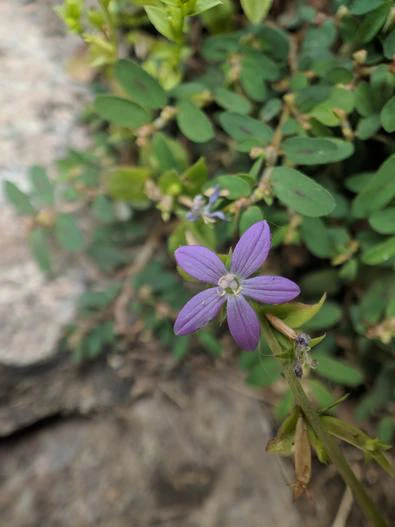Small Venus’ Looking-Glass
(Triodanis perfoliata subsp. biflora)
Small Venus’ Looking-Glass (Triodanis perfoliata subsp. biflora)
/
/

Sun Jiao (Interaccoonale)
CC BY 4.0
Image By:
Sun Jiao (Interaccoonale)
Recorded By:
Copyright:
CC BY 4.0
Copyright Notice:
Photo by: Sun Jiao (Interaccoonale) | License Type: CC BY 4.0 | License URL: https://creativecommons.org/licenses/by/4.0 | Uploader: Interaccoonale | Publisher: Wikipedia Commons



















Estimated Native Range
Climate Requirements for Brambleton, Virginia
| This Plant | Your Site | Plant Suitability for Your Location | ||
|---|---|---|---|---|
| • Precipitation | 5" - 90" | 40" | Aquatic | Aquatic |
| • High Temp. | 70°F - 97°F | 87°F | Your summer temperatures are normal for this plant. | Excellent |
| • Low Temp. | 11°F - 54°F | 23°F | Your winter temperatures are normal for this plant | Excellent |
This plant may not grow well at your location - your precipitation is too high.
Summary
Triodanis perfoliata subsp. biflora, commonly known as Small Venus’ Looking-Glass, is an annual herb that is native to a variety of habitats across North America, including prairies, meadows, open woodlands, and along roadsides. It is a rapid grower, reaching heights of 0.5-2.5 feet (0.15-0.8 meters) and is known for its distinctive purple, bell-shaped flowers that bloom in the spring and summer, adding a splash of color to the landscape. The flowers are showy, attracting pollinators such as bees and butterflies.
Small Venus’ Looking-Glass is valued for its ornamental flowers and its ability to thrive in a range of conditions, making it a versatile choice for wildflower gardens, meadow plantings, and as a filler in borders. It is relatively low-maintenance, requiring medium amounts of water and can adapt to clay, loam, or sandy soils with medium to fast drainage. It prefers full sun to part shade, which allows for optimal flowering. While it is not commonly known for any significant problems, it can self-seed prolifically, which may be undesirable in some settings.CC BY-SA 4.0
Small Venus’ Looking-Glass is valued for its ornamental flowers and its ability to thrive in a range of conditions, making it a versatile choice for wildflower gardens, meadow plantings, and as a filler in borders. It is relatively low-maintenance, requiring medium amounts of water and can adapt to clay, loam, or sandy soils with medium to fast drainage. It prefers full sun to part shade, which allows for optimal flowering. While it is not commonly known for any significant problems, it can self-seed prolifically, which may be undesirable in some settings.CC BY-SA 4.0
Plant Description
- Plant Type: Herb
- Height: 0.5-2.5 feet
- Width: 0.5-1 feet
- Growth Rate: Moderate
- Flower Color: Purple
- Flowering Season: Spring, Summer
- Leaf Retention:
Growth Requirements
- Sun: Full Sun, Part Shade
- Water: Medium
- Drainage: Medium, Fast
Common Uses
Bee Garden, Butterfly Garden, Low Maintenance
Natural Habitat
Prairies, meadows, open woodlands, and along roadsides
Other Names
Common Names: Venus’s Looking Glass, Clasping Bellwort
Scientific Names: Triodanis perfoliata subsp. biflora, Asyneuma anhuiense, Campanula biflora, Campanula intermedia, Campanula intermedia, Campanula ludoviciana, Campanula ludoviciana, Campanula montevidensis, Dysmicodon californicum
GBIF Accepted Name: Triodanis perfoliata subsp. biflora